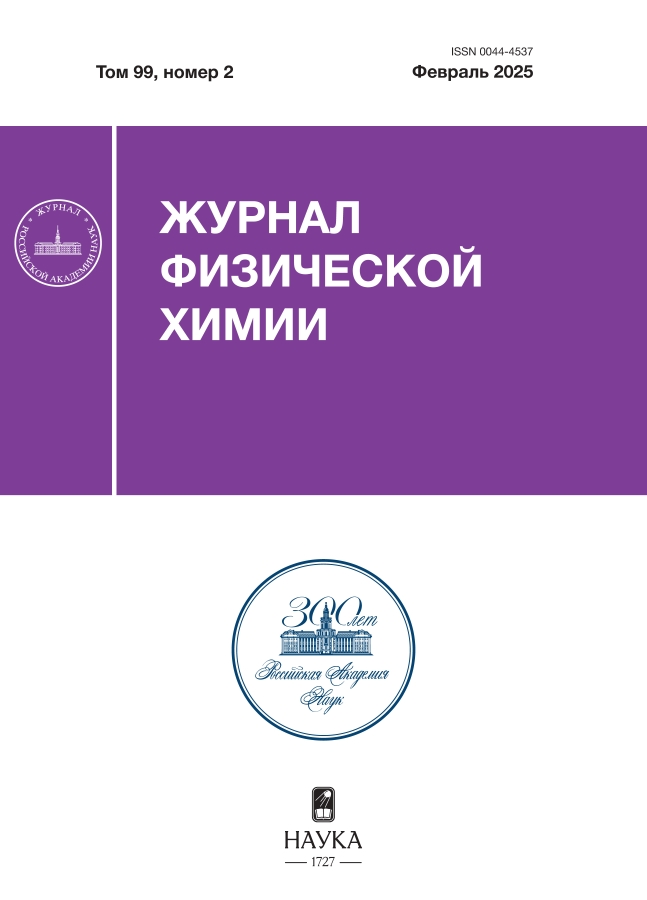Critical wetting point in the liquid lead-molten alkali metal halogenide system
- Authors: Stepanov V.P.1
-
Affiliations:
- Institute of High Temperature Electrochemistry, Ural Branch of the Russian Academy of Sciences
- Issue: Vol 99, No 2 (2025)
- Pages: 319-323
- Section: PHYSICAL CHEMISTRY OF DISPERSED SYSTEMS AND SURFACE PHENOMENA
- Submitted: 19.06.2025
- Published: 20.05.2025
- URL: https://hum-ecol.ru/0044-4537/article/view/685282
- DOI: https://doi.org/10.31857/S0044453725020181
- EDN: https://elibrary.ru/DCXJBW
- ID: 685282
Cite item
Abstract
Experimental data on the surface tension of liquid lead and molten sodium, potassium, and cesium halogenides at the interface with the gaseous phase along with the values of interfacial tension between them formed the basis for analyzing the phase transition of surface wetting in two-phase high-temperature systems. The dependence of the work of adhesion of the molted salt to the metal on temperature and nature of contacting phases is established. Conditions of transition from partial wetting of the metal surface by molted salt to the film mode are found.
Full Text
About the authors
V. P. Stepanov
Institute of High Temperature Electrochemistry, Ural Branch of the Russian Academy of Sciences
Author for correspondence.
Email: v.stepanov@ihte.ru
Russian Federation, Ekaterinburg
References
- Heady R.B., Cahn J.W. // J. Chem. Phys. 1973. V. 58. P. 896.
- Moldover M.R., Cahn J.W. // Science. 1980. V. 207. P. 1073.
- Schmidt J.W., Moldover M.R. // J. Chem. Phys. 1983. V. 79. P. 370.
- De Gennes P.G. // Rev. Mod. Phys. 1985. V. 57. P. 827.
- Bonn D. // Current Oppinion in Colloid Interface Sci. 2001. V. 6. P. 22.
- Bonn D., Eggers J., Indekeu J., Meunier J. // Rev. Mod. Phys. 2009. V. 81. P. 739.
- Cahn J.W. // J. Chem. Phys. 1977. V. 66. P. 3667.
- Степанов В.П. // Журн. физ. химии. 2023. Т. 97. С. 1660.
- Pershin P., Khalimullina Yu., Arkhipov P., Zaikov Yu. // J. Electrochem. Soc. 2014. V. 161. D824–D830.
- Arkhipov P.A., Zaikov Yu.P., Khalimullina Yu.R. et al. // J. Mol. Liquids. 2022. V. 361. P. 119619.
- Лебедев В.А. Избирательность жидкометаллических электродов в расплавленных галогенидах. Челябинск: Металлургия, 1993.
- Lewin R.G., Harrison M.T. Reprocessing and recycling of spent nuclear fuel. Cambridge: Woodhead Publishing Series in Energy. 2015.
- Mirza M., Abdulaziz R., Maskell W.C. et al. // Energy Environ. Sci. 2023. V. 16. P. 952.
- Исаева Л.А., Поляков П.В., Михалев Ю.Г., Рогозин Ю.Н. // Электрохимия. 1984. Т. 20. С. 957.
- Степанов В.П. Межфазные явления в ионных солевых расплавах. Екатеринбург: УИФ “Наука”, 1993.
- Tanaka T., Nakamoto M., Oguni R. et al. // Z. Metallkunde. 2004. V. 95. P. 818.
- Smirnov M.V., Stepanov V.P. // Electrochim. Аcta. 1982. V. 27. P. 1551.
- Справочник химика / Под ред. Б.П. Никольского. Л.-М.: ГХИ. 1962. Т. 1.
- Chaudhary S., Ranjan P., Chakraborty T. // J. Chem. Res. 2020. V. 44. P. 227.
- Делимарский Ю.К. Электрохимия ионных расплавов. М.: Металлургия, 1978.
Supplementary files















